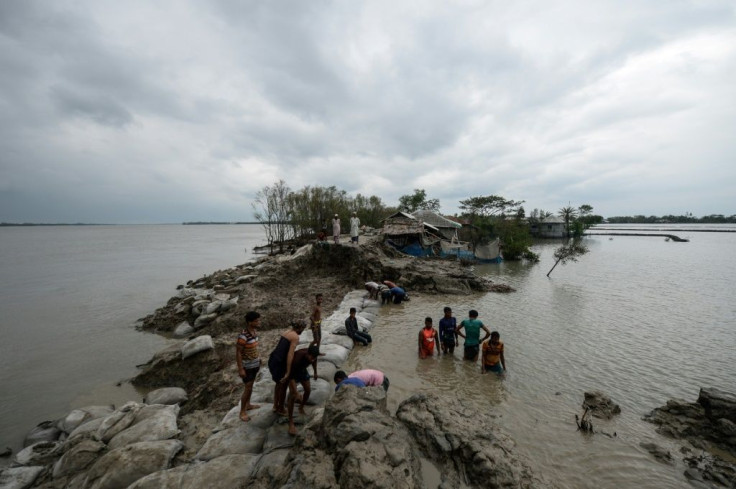Cyclone Amphan Devastates Parts Of West Bengal, India, Coastal Bangladesh

KEY POINTS
- Most of the people who died were either electrocuted or killed by uprooted trees
- Amphan made landfall on Wednesday bringing with it storm surges of 16 feet
- In Kolkata, the airport has been flooded
Super Cyclone Amphan has killed at least 80 people in eastern India and Bangladesh, knocked out power in the city of Kolkata, flooded coastal areas and carved a swath of destruction across the region.
In the Indian state of West Bengal, streets are flooded, roads are blocked by uprooted trees and thousands of homes and buildings are damaged.
Most of the people who died were either electrocuted or killed by uprooted trees.
However, officials said it’s too early to assess the full damage imparted by the deadly storm. Lack of communication in remote locations makes an accurate assessment even more difficult.
Shuli Ghosh, a café owner in Kolkata, said: “The roofs of many homes have flown away and the streets are waterlogged.”
Amphan made landfall on Wednesday bringing with it storm surges of 16 feet, sustained winds of 105 mph and gusts up to 118 mph.
Countless lives were likely saved through the evacuation of millions prior to the storm's arrival.
“I have never seen such a disaster before,” said West Bengal Chief Minister Mamata Banerjee.
She noted that the government will pay $3,310 to families who lost a relative in the storm.
“Two districts [of West Bengal] North and South 24 Parganas are completely devastated. We have to rebuild those districts from scratch. I would urge the central government to extend all help to the state," Banerjee said. "I will visit the affected areas very soon. The restoration work will start soon. A large part of North and South 24 Parganas and Kolkata are facing massive power cuts... Even telephone and mobile connections are down.”
In Kolkata, the airport has been flooded and more than 1,000 mobile phone towers have been destroyed.
“It is not the city where I have grown up... it seems to be a destroyed one. It seems there was a war yesterday... I cannot believe that this is my Calcutta,” said Sudhir Chakraborty, a resident of Calcutta's Rashbehari area.
Banerjee also announced a 10-billion rupee ($130 million) emergency fund to help rebuild roads, water and health systems.
“These areas have been devastated,” she said.
Thousands of people in West Bengal have become homeless.
"Tens of thousands of… houses, trees and electric poles have collapsed… At least 15 embankments were breached. Telephone connectivity is badly affected," a West Bengal official said. "In Minakhan [district] alone, 5,200 houses have collapsed. Dozens of places are as badly affected or worse.”
Banerjee also ordered local officials to plant mangroves in the Sundarbans, a delta region of about 200 islands in the Bay of Bengal where some 13 million Indians and Bangladeshis live. The Sundarbans is renowned for its mangrove forests and rare Bengal tigers.
“The tidal surge submerged part of the [Sundarbans] forest,” said Belayet Hossain, a forest official in Bangladeshi. “We have seen trees uprooted, the tin roofs of the guard towers blown off.”
Indian Prime Minister Narendra Modi vowed to deliver assistance to Indians victimized by the cyclone. “No stone will be left unturned in helping the affected,” he tweeted. “Have been seeing visuals from West Bengal on the devastation caused by Cyclone Amphan. In this challenging hour, the entire nation stands in solidarity with West Bengal. Praying for the well-being of the people of the state. Efforts are on to ensure normalcy.”
Banerjee has urged Modi to visit parts of West Bengal devastated by the cyclone.
"I have never witnessed such a fierce cyclone and destruction in my life. I would request Prime Minister Narendra Modi to come and visit Cyclone Amphan-affected areas," Banerjee said.
In the Indian state of Odisha, just south of West Bengal, the storm destroyed crops of betel leaves and some infrastructure, although no deaths have been reported yet.
In Bangladesh, some 10 million people are without electricity, according to Moin Uddin, chairman of the Bangladesh Rural Electrification Board. Hundreds of Bangladeshi villages have been flooded, while the coronavirus pandemic has complicated efforts to get evacuees into shelters.
“I have never seen such a cyclone in my life. It seemed like the end of the world,” said Azgar Ali, a 49-year-old resident of Satkhira on the Bangladeshi coast. “All I could do was to pray ... Almighty Allah saved us.”
Enamur Rahman, Bangladeshi’s junior minister for disaster management, said the cyclone has caused at least $130 million in damage to infrastructure, housing, fisheries, livestock, water resources and agriculture.
Rahman also said that more than 494,000 acres of land, 680 miles of roads, 150 flood-protection embankments and 200,000 shrimp farms have been damaged. In Bangladesh’s southwestern Bagerhat district, more than 500 fish farms were flooded.
While low-lying Bangladesh has long endured cyclones and flooding, Amphan was especially fierce.
“We’ve received reports that more than 5 million people were disconnected from the electricity grid for their own safety as winds of [93 mph] smashed into power lines, destroying homes and uprooting trees,” said Mostak Hussain, humanitarian director for Save the Children in Bangladesh.
© Copyright IBTimes 2025. All rights reserved.





















